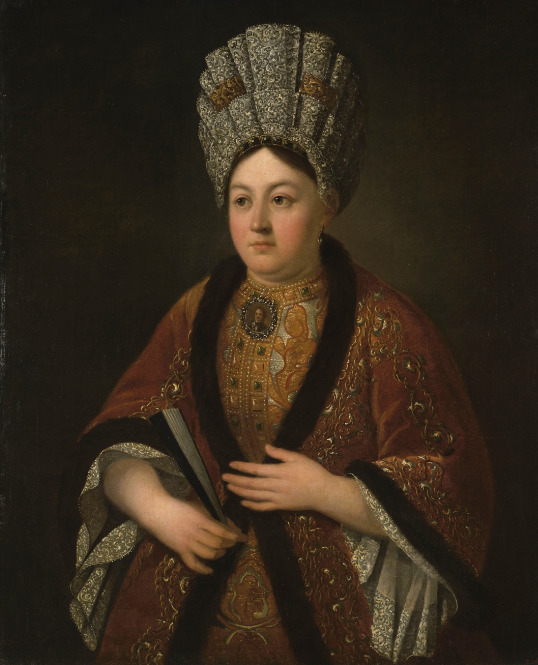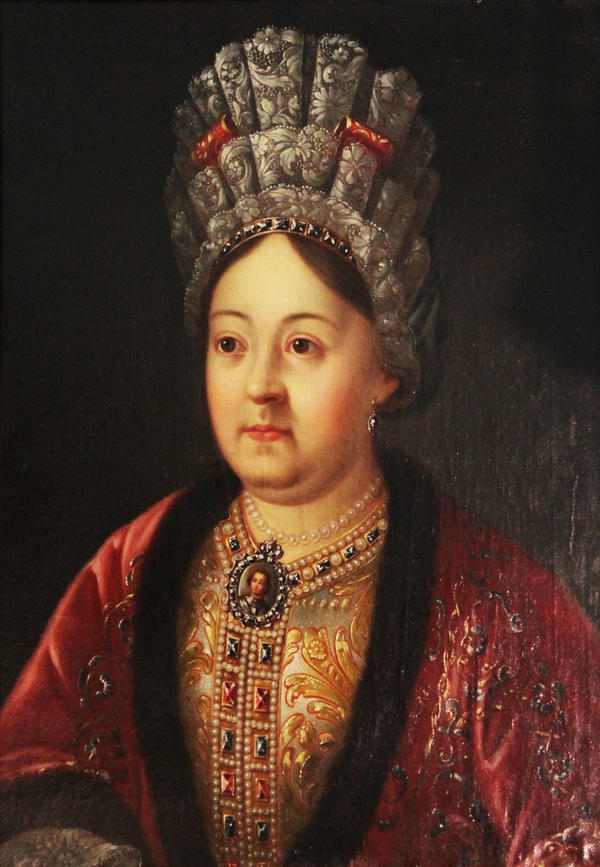The Portrait of Baroness Maria Stroganova arrived at the Tambov Regional Ethnography Museum from the Stroganovs’ estate in 1919. This is a copy made by an unknown artist from the work by portraitist Roman Nikitin.
1 / 2
Portrait of Baroness Stroganova
Creation period
19th century
Dimensions
67x51 cm
Technique
Oil on canvas
Collection
Exhibition
9
Open in app#1
Unknown author
Portrait of Baroness Stroganova
#8
#12
Portrait of Baroness Maria Yakovlevna Stroganova. R. Nikitin. Not earlier than May 1724. The State Russian Museum.
#9
Painter Roman Nikitin created the original portrait of Baroness Stroganova not earlier than May 1724. Nikitin was one of the first Russian artists to work in the West-European style. In 1716, icon painter Roman, his brother Ivan and Andrey Matveyev were sent by Emperor Peter the Great to study in Florence, Venice and Rome. Roman Nikitin took the time to work in Paris as well. He returned to Russia in 1721. The Portrait of Maria Stroganova is one of the few works by the artist, which reliably belongs to Nikitin’s brush. In terms of the technique, it still bears some traces of the traditional parsuna, a secular icon. The image is fairly flat and static and the portrait does not render Stroganova’s individuality and character but unmistakably presents her as belonging to a noble family. The Baroness is wearing a dress in the old Moscow style — with ornate pearl and precious stone embroidery. The sleeves are decorated with rich lacing. On top of the dress the Baroness is wearing a brown fur coat with silver and gold embroidery and fur trimming.
Maria Stroganova owned one of the biggest estates in the 18th century Russia. Peter the Great was her second son Nikolai’s god father. After her husband Grigory’s death in 1715, for five years Stroganova had managed her patrimonies on her own until her son came of age. She did a lot of charity work, helped monasteries. Due to Maria’s influence, the Stroganov family was given the title of Barons of the Russian Empire in 1722. From 1724, she was lady-in-waiting at the Russian court of Empress Catherine I, and later kept her post under Anna Ioannovna when she came to power in 1730. Maria Stroganova used to take orphaned noble young ladies to her home, brought them up and provided them with their dowry at her own expense. Baroness Stroganova died in 1733. She was buried next to her husband at the graveyard of the Church of St. Nikolas the Wonderworker.
After the October 1917 revolution, articles of art from noblemen’s estates were nationalised and given to museums. The collection of art from the Strognov estate which was kept in the village of Znamenka near the city of Tambov was no exception. In August 1918, Instructor of the Guberniya Commissariat for Education Konstantin Tulupov began evacuation of the Stroganovs’ art valuables from Znamenka. The portrait from the Tambov Local History Museum is mentioned on the list compiled by Tulupov as the Portrait of Maria Nikolayevna Stroganova (née Novosiltseva).
Maria Stroganova owned one of the biggest estates in the 18th century Russia. Peter the Great was her second son Nikolai’s god father. After her husband Grigory’s death in 1715, for five years Stroganova had managed her patrimonies on her own until her son came of age. She did a lot of charity work, helped monasteries. Due to Maria’s influence, the Stroganov family was given the title of Barons of the Russian Empire in 1722. From 1724, she was lady-in-waiting at the Russian court of Empress Catherine I, and later kept her post under Anna Ioannovna when she came to power in 1730. Maria Stroganova used to take orphaned noble young ladies to her home, brought them up and provided them with their dowry at her own expense. Baroness Stroganova died in 1733. She was buried next to her husband at the graveyard of the Church of St. Nikolas the Wonderworker.
After the October 1917 revolution, articles of art from noblemen’s estates were nationalised and given to museums. The collection of art from the Strognov estate which was kept in the village of Znamenka near the city of Tambov was no exception. In August 1918, Instructor of the Guberniya Commissariat for Education Konstantin Tulupov began evacuation of the Stroganovs’ art valuables from Znamenka. The portrait from the Tambov Local History Museum is mentioned on the list compiled by Tulupov as the Portrait of Maria Nikolayevna Stroganova (née Novosiltseva).
#13
The Tambov Regional Ethnography Museum
read morehide
00:00
00:00
1x
Portrait of Baroness Stroganova
Creation period
19th century
Dimensions
67x51 cm
Technique
Oil on canvas
Collection
Exhibition
9
Open in app
Share





